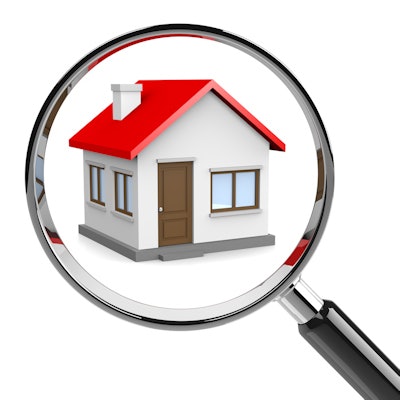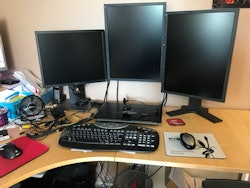
Whether you're a single reporter or part of a larger team, determination is a crucial factor in the success of a home-reporting service. From the planning phase to setting up and implementation, starting a scheme can be difficult in the early days but the end result is worth it, according to home reporters.
The provision of hardware and software, and its ongoing support, has generated the largest proportion of work in the setup of 23 home-reporting workstations, noted Dr. Stephen Fenn, consultant radiologist and radiology lead for IT at Hampshire Hospitals National Health Service (NHS) Foundation Trust in the U.K.
 The home-reporting experience has been so positive that a wider project to equip all radiologists with home kit has begun, Dr. Stephen Fenn said.
The home-reporting experience has been so positive that a wider project to equip all radiologists with home kit has begun, Dr. Stephen Fenn said.Many users feel unable to transport and install an expensive kit at home by themselves, he explained, pointing to last month's WannaCry ransomware attack that highlighted the need for regular and prompt installation of software patches, particularly to the operating system.
"Trying to do this to 20 or more remote machines, which for good reasons may not be on the domain and so require manual installation, is complicated and time-consuming to say the least. Factor in the fact that some users have broadband speeds of < 4 Mbps, the time taken just to download large patches becomes significant," Fenn explained.
When problems can't be fixed remotely, he points to the possibility that users may be expected to return expensive workstations to onsite IT departments, to then face the difficulties of reinstalling the fixed kit, often involving cabling between a workstation and three displays.
"For us, it has proven impossible to source any sort of support package from a third-party supplier. In the end, our institution's IT department has offered 'best endeavors' support, but realistically this will be limited to office hours on weekdays, which may not be when home reporting is carried out, assuming a mix of home and institutional reporting," he said.
The best software solution
The chosen software solution must function in the completely different environment of a home broadband/VPN setting, Fenn continued. In the U.K., for instance, many users will have broadband speeds of < 4 Mbps compared with 1 Gbps onsite, clearly limiting system performance if 2,000-slice CTs are downloaded on demand, along with relevant priors.
Similarly, software that makes multiple connections back to the server during normal use will function fine in the low-latency institution setting, but at home this may result in unacceptable user interface responsiveness and image download speed, he said. Even if imaging can be precached over a slow connection so it is already at home, the user experience can still be suboptimal if the system is designed to download PACS folder lists, imaging request details, prior reports, and imaging history details on demand, and also keep a 1 GB voice recognition user profile up to date between on- and offsite locations.
Negotiating finances
From an institution's point of view, the flexibility of home reporting can be a challenge, as although reporting capacity is increased, not knowing when and how much reporting activity is likely each day makes balancing scanning activity with reporting capacity almost impossible, according to Fenn. This is further hampered by the likelihood that the times of most reduced onsite reporting capacity, such as school holidays, will match reduced home reporting activity. For this reason, some departments may want to insist on certain volumes of reporting activity each week.
 A good home setup can provide improved throughput and potential savings, with ultimate flexibility for the radiologist. Shown here is Dr. Stephen Fenn's setup.
A good home setup can provide improved throughput and potential savings, with ultimate flexibility for the radiologist. Shown here is Dr. Stephen Fenn's setup.Fenn suggests the largest barrier to institutions adding home reporting to an existing imaging service or PACS contract may be the somewhat intangible financial aspect of the benefits. Faced with the significant capital or revenue expense of installing and supporting reporting hardware at home, boards may need some persuading to take on the additional costs.
"Looking forward as an institution through 2017, rather than trying to secure additional funding from the cash-strapped board, it was decided to redirect an existing revenue stream into providing the same or more reporting capacity from all radiologists being able to report from home," he stated.
Remuneration rates for flexible home reporting will be set by local negotiation with several models available, according to Fenn. As a baseline, an institution may look at what it is already paying for the work to be performed, via one of the many outsourcing companies providing additional reporting capacity in the U.K., for example. Alternatively, one consortium is basing payments on the reporting component of the NHS tariff, which is a significantly smaller figure, Fenn said.
All parties will also need to consider whether the trust or the individual is providing the reporting hardware. At the end of the day, the institution is unlikely to breakeven through this process, so it must see it both as an investment necessary to provide adequate reporting capacity and as a means to actively improve radiologist recruitment and retention, he noted.
There are also other factors to consider when looking at the options for starting home reporting. Outsourcing companies tend to demand a fixed number of reporting sessions at fixed times each week, which isn't very flexible, according to Fenn. They may also want radiologists to commit to some overnight work.
The future of imaging
Having a reporting workstation at home is the future of radiology, believes radiologist Dr. Julian Elford, Fenn's colleague at the Hampshire Hospitals NHS Trust.
 A workstation at home is the future of radiology, Dr. Julian Elford said.
A workstation at home is the future of radiology, Dr. Julian Elford said."Having the workstation at home helps me to be as flexible, efficient, and productive as possible. I can report whenever I want for as much or as little time as I want, without having to leave my house," Eldford said.
Home reporting is not without its disadvantages, however. It can be more difficult to access peers -- and, for clinicians, more difficult access to radiologists is considered to be one of its key drawbacks. Detractors may even view home reporting as undermining provision of onsite radiologists, while contributing to professional isolation. Those with experience of this setup cite more advantages than disadvantages, including fewer interruptions, financial savings, and potentially more reliable throughput in a relaxed environment.
Reporting for your own trust on familiar kit, especially PACS, scanners whose sequences you know and referrers with whom you already have a clinical relationship, is certainly more tempting than the alternative," Fenn said. "Flexible home reporting may also provide ultimate flexibility in terms of timing and volume of reporting, perhaps with only a bare minimum expected each week, but with the opportunity to 'flex up' significantly if your personal life allows."
Fenn's personal experience is that investing in home reporting last year has been a great step, providing a significantly improved work-life balance, despite the large cost of the kit.
"Being able to choose when and how much reporting I do each week allows me to maintain my income level, but with more time to spend with my family during the week. As this was a pilot project, we did have to fund the kit ourselves and the support options are less robust than we would like, but none of us would go back. In fact, the experience has been so positive that a wider project to equip all radiologists with home kit is now being undertaken," he concluded.



















